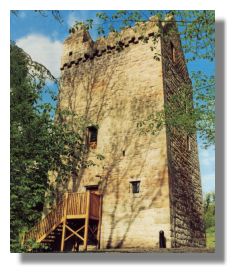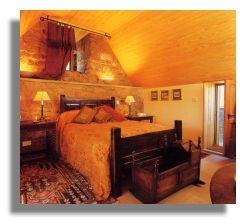 The Tower of Hallbar or alternatively, the Castle of Braidwood, is on the lands of the Barony of Braidwood, which had first been conferred to John de Monfod by King Robert the Bruce in 1326 for "homage and service". The Tower itself was likely to have been built in response to an Act of Parliament in 1535 instructing those with land of a value of £ 100 to construct a tower, thirty feet square to protect himself and the local people from English Border Raiders.
The Tower of Hallbar or alternatively, the Castle of Braidwood, is on the lands of the Barony of Braidwood, which had first been conferred to John de Monfod by King Robert the Bruce in 1326 for "homage and service". The Tower itself was likely to have been built in response to an Act of Parliament in 1535 instructing those with land of a value of £ 100 to construct a tower, thirty feet square to protect himself and the local people from English Border Raiders.
The name comes form the Gaelic word - bar, meaning height. Therefore it translates as High Hall. Hallbar is a fine example of the typical tower houses which were built from the end of the thirteenth century and onwards, designed as strong fortified dwellings in which the owner`s household, and neighbours, could take refuge when under attack.
It is a square tower built in the old Scots Baronial style, characterised by the old Norman, "donjon", a strong central room, or dungeon for protection. There are five apartments stacked one upon the other. The dog-leg series of straight stairs is unusual, where a spiral staircase is normal for similar towers in the Borders.
There are historic documents relating to the transfer of the Barony of Broadwood to Harie Stewart of Gogar, brother of the Earl of Arran. Harie became briefly James VI's Chancellor but later, on his downfall from such an illustrious position at Court, the Tower seems to have passed to his enemy and successor Lord Maitland of Thirlestane Castle, Berwickshire.
The Tower has been in the possession of the Lochhart family since 1681 when Sir George Lockhart at neighbouring Lee Castle, purchased it from James, Marquis of Douglas.
Little is known about its inhabitants or use until the mid 19th century, when the tower had fallen into disrepair. There is actually a drawing by a Mr. A. Archer illustrating the roofless tower. But in 1861, the then owner and Laird, the seventeen year old Sir Norman Macdonald Lockhart, decided to restore the property, rebuilding the garret, the crow-stepped gables and creating a slate roof. During these refurbishments a touch of "modern" sanitation in the form of the garderobe was added, as well as a cast iron range in the fireplace.
Once the tower was weatherproof and habitable, it was leased to tenants - rather than the Lockart family themselves moving in to this rather unusual dwelling. But some people found it extremely comfortable and homely it seems. From 1947 to 1969. The Rev. Neville Davidson, a prominent and distinguished minister of Glasgow Cathedral very wisely used it for a weekend retreat. He became so attached to the tower that he wished to purchase it but the then Laird, Simon MacDonald Lockhart declined his offer. The last tenant, Mr. Edmund, left in 1984, after a lease of fifteen years.
Thereafter vandalism, rain and frost damage brought about the recent decay and structural problems. It was in 1998 when the Vivat Trust took over a 50 year repairing lease in order to preserve the Grade A listed Ancient monument for the nation.
Vivat Trust
 The Vivat Trust is a charity dedicated to saving dilapidated and neglected properties and, without a private endowment, requires to raise the finance on a project by project basis through the National Lottery, Architectural Heritage funds, public and private trusts and grants.
The Vivat Trust is a charity dedicated to saving dilapidated and neglected properties and, without a private endowment, requires to raise the finance on a project by project basis through the National Lottery, Architectural Heritage funds, public and private trusts and grants.
Once the building is repaired it must be self-financing and therefore all of Vivat`s properties are currently let out as unusual and very distinctive, often luxurious, holiday accommodation. This guarantees an income to finance the continuing maintenance of these valuable historic buildings.
The structural renovation and basic repair of the Tower of Hallbar has been a most valuable and vital project but what is outstanding is the superior quality of interior decoration with fabrics and furnishings utterly in keeping with the period of the 16th century Tower. How on earth was the huge heavy oak double bed, tables and chests, carried up to the Turret? Apparently hoisted by rope and winch right up the outside and over the battlements.
From the old candlesticks dripping with wax, velvet drapes, the recreation of the old orchards around the estate and replanting of original garden flowers - foxgloves, Michaelmas daisies and ragged robin - around the garden this is a restoration project par excellence.
Staying for a few days or a week or so at the Tower of Hallbar - and the other Vivat properties around the United Kingdom - is an extraordinary experience of living history, as you feel, touch, breathe, and smell the centuries old atmosphere of the house.
And of course just by renting a Vivat property, and enjoying a holiday there, you are directly helping to preserve for posterity some of the most important monuments, temples and towers of Britain`s heritage.



